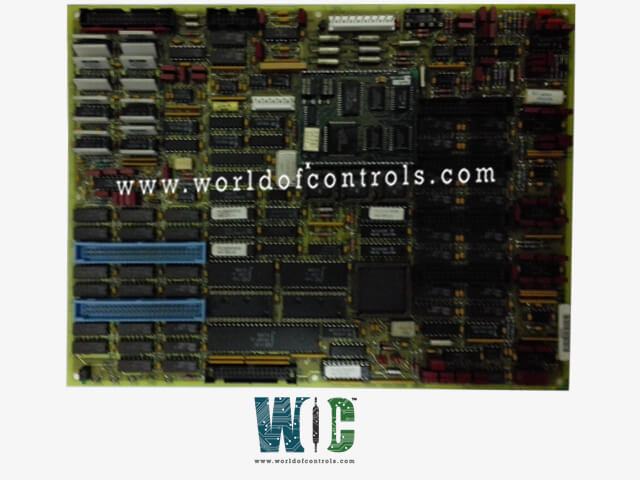SPECIFICATIONS
Part No.: DS200TCCAG1AAA
Manufacturer: General Electric
Country of Manufacture: United States of America (USA)
Product Type: Common Analog I/O Board
Availability: In Stock
Series: Mark V
Functional Description
DS200TCCAG1AAA is a common analog I/O board developed by GE. It is a part of the Mark V control system. The Common Analog I/O Board, situated in the R5 core, functions by processing analog signals within the control system. The board is responsible for scaling and conditioning various analog signals received from the CTBA, TBQA, and TBCA terminal boards, which are also mounted in the R5 core.
Types of Signals Handled
- 4-20 mA Inputs and Outputs: These standardized current signals are widely used for transmitting information over long distances with high noise immunity. The TCCA board ensures these signals are accurately scaled and conditioned for use in the control system.
- RTD Inputs: Resistance Temperature Detectors (RTDs) are used for precise temperature measurements. The TCCA board processes these signals, ensuring they are correctly scaled and conditioned for accurate temperature monitoring.
- Thermocouple Inputs: Thermocouples are another type of temperature measurement device. The TCCA board conditions these signals to ensure reliable temperature readings.
- Shaft Voltage Inputs: These signals monitor the voltage levels on a rotating shaft, which is important for detecting electrical imbalances or insulation issues. The TCCA board scales and conditions these inputs for accurate monitoring.
- Shaft Current Inputs: Similar to shaft voltage inputs, these signals monitor the current levels on a rotating shaft. Proper scaling and conditioning by the TCCA board ensure accurate detection of electrical anomalies.
Signal Processing and Communication
- The analog signals are processed by the board for monitoring and control functions within the system.
- After scaling and conditioning, these signals are written to the STCA board via the 3PL connector. This connection ensures that the necessary data is transmitted accurately and efficiently, enabling the STCA board to perform its designated control and monitoring tasks effectively.
RTD Measurement
- Signal Processing by Board: The board is responsible for measuring, scaling, and conditioning the voltage signal from the RTD. It ensures that the voltage signal accurately reflects the temperature variations detected by the RTD.
- Signal Transmission: RTD signals are transmitted from the TBCA terminal board to the board via the JCC and JDD connectors. Once processed, these signals are further relayed to the I/O Engine through the 3PL connector.
- Configuration: The type of RTD used is selected and configured using I/O configuration constants. This allows the system to adapt to different types of RTDs with varying characteristics and temperature ranges.
Thermocouple Circuit on the Board
- Cold Junction Compensation: The TBQA terminal board provides cold junction signals through dedicated circuitry. These signals are essential for compensating the temperature readings from thermocouples, as they account for variations in the ambient temperature at the point where the thermocouple wires connect to the system.
- Calculation of Actual Temperature: Using the thermocouple input and the cold junction compensation values, calculate the actual temperature detected by the thermocouple. This calculation ensures precise temperature measurement across different environmental conditions.
- Signal Transmission: Similar to the RTD signals, the board transmits the processed thermocouple signals to the I/O via the 3PL connector. This communication pathway facilitates the integration of temperature data into the broader control and monitoring system.
- Configuration: Thermocouple types and specific calibration curves are selected using I/O configuration constants. These constants allow the system to interpret the thermocouple signals correctly, adjusting for the unique characteristics of different thermocouple types.
The WOC team is always available to help you with your Mark V requirements. For more information, please contact WOC.
Frequently Asked Questions
What is DS200TCCAG1AAA?
It is a common analog I/O board developed by GE under the Mark V series.
How are RTD signals transmitted within the system?
RTD signals are read from the TBCA terminal board by the board through the JCC and JDD connectors. Once processed, these signals are sent to the I/O via the 3PL connector for further integration into the control system.
What type of RTD can the system accommodate?
The type of RTD used is selected using I/O configuration constants. This allows the system to adapt to different types of RTDs with varying characteristics and temperature ranges.
What role does the board play in managing thermocouple inputs?
The board calculates actual temperatures from thermocouple inputs, using compensation values for cold junction temperatures provided by the TBQA terminal board. This ensures accurate temperature readings under varying environmental conditions.
